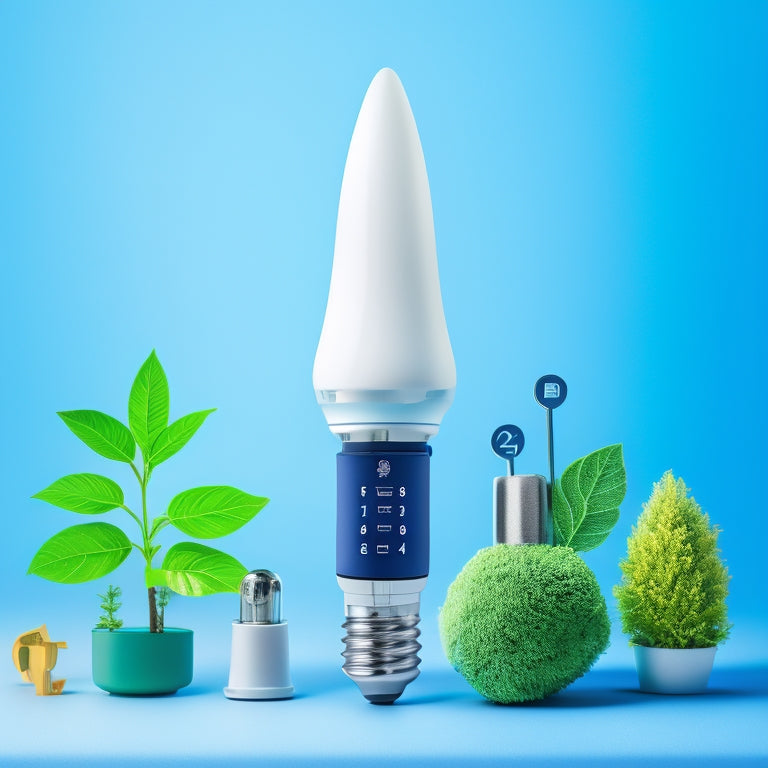
What Rebates Can You Get for Energy-Saving Plugs?
Share
You can tap into a wealth of rebates and incentives for energy-saving plugs from federal and state governments, utility companies, manufacturers, and local authorities. Federal programs offer tax credits for energy-saving technologies, while state-specific initiatives provide appliance rebates. Utility companies offer discounts or incentives for energy-saving devices, and manufacturers provide rebates and discounts for smart plug purchases. Local governments provide grants for energy efficiency projects, and Energy Star certified products qualify for rebates. With so many opportunities available, you'll want to investigate further to maximize your savings and find the perfect fit for your energy-efficient upgrades.
Key Takeaways
- Federal programs offer rebates and incentives for energy-efficient practices, including energy-saving plugs.
- Utility companies provide incentives for energy-efficient products, including smart plugs, with rebates from companies like BGE, Pepco, and Delmarva Power.
- Manufacturers of energy-saving plugs often offer rebates and discounts that can be combined with federal and state tax credit opportunities.
- Local governments provide grants for energy efficiency projects, including smart plugs, reducing upfront costs for energy-saving devices.
- ENERGY STAR programs provide incentives for smart plugs that meet energy-saving standards, with rebates available for certified products.
Federal Incentives for Energy Efficiency
Several federal programs offer rebates and incentives to encourage homeowners and businesses to adopt energy-efficient practices, and you can take advantage of these initiatives to reduce your energy consumption and lower your utility bills.
The federal government provides financial incentives, such as federal tax credits, to encourage the adoption of energy-efficient technologies. For instance, the new clean vehicle credit and previously-owned clean vehicle credit federal tax credits can be claimed on your tax return, which can help offset the cost of purchasing energy-saving plugs.
Additionally, energy efficiency grants are available to support projects that reduce energy consumption. These grants can be used to fund projects that involve installing energy-efficient equipment, including energy-saving plugs.
State-Specific Rebate Programs Available
While federal incentives provide a foundation for energy-efficient initiatives, state-specific rebate programs offer additional opportunities for homeowners and businesses to save money on energy-saving plugs.
You can take advantage of these programs to reduce your energy consumption and lower your utility bills. Utility companies, such as Southern California Edison, also offer rebate programs to lower installation and operational costs for EV charging stations, which can be applied to energy-saving plugs as well.
State programs vary, but many offer rebates for energy-saving plugs, smart strips, and other energy-efficient devices. For instance, California's Energy Upgrade California program provides rebates for energy-efficient appliances, including smart plugs.
Similarly, New York's NYSERDA program offers rebates for energy-efficient lighting and appliances. Research your state's energy saving initiatives to find out what rebates are available to you.
Utility Company Energy-Saving Offers
Taking advantage of utility company energy-saving offers can be a lucrative way to offset the cost of energy-saving plugs.
Many utility companies, such as BGE, Pepco, and Delmarva Power, offer incentives for energy-efficient products like smart plugs, similar to their EV charging equipment rebates.
You can investigate the various utility programs offered by your provider, which may include rebates, discounts, or other incentives for energy-efficient products like smart plugs.
These programs are designed to encourage customers to reduce their energy consumption, and you can benefit from them.
By participating in these programs, you can enjoy significant energy savings, which can add up over time.
Be sure to check with your utility company to see what offers are available, as they can vary depending on your location and provider.
Manufacturer Rebates for Smart Plugs
Many manufacturers of energy-saving plugs offer rebates and discounts to incentivize customers to purchase their products. You can take advantage of these deals to save even more on your smart plug purchases.
Additionally, federal and state governments offer tax credit opportunities for businesses investing in energy-saving infrastructure, which can be combined with manufacturer rebates for even greater savings.
Look for manufacturer partnerships with retailers, which often provide instant rebates or discounts at checkout. Some manufacturers also offer mail-in rebates or online coupons that you can redeem after purchasing their smart plugs.
Be sure to check the manufacturer's website or product packaging for available rebates and follow the redemption instructions carefully.
Local Government Energy Efficiency Grants
Local governments often provide energy efficiency grants to residents and businesses, offering a worthwhile opportunity to offset the cost of smart plug installations.
These grants can be a great way to reduce the upfront cost of energy-saving devices and invest in a more sustainable future. In addition, government funding for EV charging infrastructure can also provide a model for local energy programs, with Federal subsidies playing an essential role in supporting clean transportation initiatives.
Moreover, leveraging incentives and partnerships can aid in overcoming financial obstacles in the EV market investment.
You can take advantage of local energy programs and community initiatives by researching and applying for grants in your area. These grants support community initiatives that promote sustainability and environmental stewardship.
- Energy Efficiency Incentive Programs: Many local governments offer rebates or incentives for energy-efficient upgrades, including smart plugs.
- Sustainable Community Grants: These grants support community initiatives that promote sustainability and environmental stewardship.
- Green Infrastructure Grants: These grants fund projects that reduce energy consumption and promote green infrastructure.
- Home Energy Renovation Grants: These grants provide funding for home energy renovations, including the installation of energy-saving devices like smart plugs.
Remember to research and review the eligibility criteria and application process for each grant before applying.
Smart Home Device Incentives Overview
You'll find various smart home rebate options available, which can help offset the cost of energy-efficient devices.
These energy efficiency incentives are designed to encourage homeowners like you to invest in smart technologies that reduce energy consumption.
Smart Home Rebate Options
Smart home devices have revolutionized the way we conserve energy, and utility companies are taking notice. You can now take advantage of rebates and incentives offered by these companies to upgrade your home with smart home automation and energy management devices.
Some popular smart home rebate options include:
-
Smart Thermostats: Utility companies offer rebates up to $100 for smart thermostats that learn your schedule and preferences to optimize heating and cooling.
-
Smart Plugs: Get up to $20 rebates for smart plugs that allow you to control and monitor energy usage of individual appliances.
-
Energy Monitors: Receive up to $50 rebates for energy monitors that provide real-time energy usage data to help you identify areas for improvement.
- Home Automation Hubs: Some utility companies offer rebates up to $100 for home automation hubs that integrate multiple smart devices and provide advanced energy management features.
These rebates can help you take the first step towards a smarter, more energy-efficient home.
Energy Efficiency Incentives
Your utility company's energy efficiency incentives can be a great motivator to upgrade your home with smart devices, and for good reason: these incentives can greatly offset the cost of investing in energy-saving technologies.
By conducting energy audits, you can identify areas in your home where energy is being wasted, and then use that information to make targeted upgrades. This can make you eligible for rebates on energy-efficient devices, such as smart plugs.
You'll need to check with your utility company to see what specific incentives are available in your area, but it's worth the effort - you could save hundreds on your energy bills and enjoy a more comfortable, convenient home.
Device-Specific Savings Opportunities
Several smart home devices, including energy-saving plugs, are eligible for rebates and incentives, and understanding these opportunities can help you maximize your savings.
By taking advantage of these device-specific rebates, you can offset the cost of investing in energy-efficient solutions. Here are some smart plug benefits you can capitalize on:
-
Utility rebates: Many utility companies offer rebates for smart plugs with energy saving features, such as scheduling and remote monitoring.
-
Manufacturer incentives: Some manufacturers offer discounts or rewards for purchasing their smart plugs, especially when bundled with other energy-efficient devices.
-
State and local incentives: Governments often provide rebates or tax credits for energy-efficient upgrades, including smart plugs.
- Energy efficiency programs: Some programs, like ENERGY STAR, offer rebates and incentives for smart plugs that meet specific energy-saving standards.
Energy Star Certified Product Rebates
Purchasing energy-efficient products certified by Energy Star, a program run by the U.S. Environmental Protection Agency, can be a great way to implement energy saving strategies in your home or business.
You can find Energy Star certified products in various categories, including energy-saving plugs, lighting, and appliances. When shopping for these products, look for the Energy Star label, which indicates that they meet energy efficiency standards set by the EPA.
You can claim rebates on these certified products, which can help offset their cost. To apply for a rebate, you'll need to submit a rebate application, usually through the manufacturer's website or a local utility company's program.
Be sure to check the specific requirements and deadlines for the rebate application process.
Green Technology Tax Credits Explained
You're likely wondering what energy-efficient products qualify for green technology tax credits and how to claim them.
Eligible items include energy-saving plugs, solar panels, and energy-efficient appliances, among others.
When claiming energy efficiency incentives, you'll need to keep receipts and manufacturer certifications to support your tax credit claims.
Eligible Tax Credit Items
With the passage of the Energy Policy Act of 2005, homeowners can now reap the benefits of green technology tax credits, which provide a significant incentive to invest in energy-efficient solutions.
To determine tax credit eligibility, you'll want to focus on energy saving devices that meet specific standards. Here are some eligible items:
-
Energy-efficient windows: Windows with a U-factor of 0.30 or less and a Solar Heat Gain Coefficient of 0.30 or less.
-
Insulation materials: Insulation that meets the 2009 IECC standards for your region.
-
Energy-efficient doors: Doors with a U-factor of 0.30 or less and a Solar Heat Gain Coefficient of 0.30 or less.
- Qualified energy-efficient improvements: Improvements like solar panels, fuel cells, and small wind turbines that generate renewable energy.
These items can help you qualify for significant tax credits, giving you the freedom to invest in a more sustainable future.
Claiming Energy Efficiency Incentives
To claim energy efficiency incentives, it's essential to understand the claiming process for green technology tax credits, which can greatly offset the cost of your energy-efficient upgrades.
You'll need to gather receipts and documentation for your energy-saving strategies, including the purchase and installation of plug efficiency devices.
Next, review the IRS guidelines and forms required for claiming the credits, such as Form 5695 for residential energy credits.
Be sure to calculate the credit amount accurately, as it's based on the cost of qualified energy-efficient improvements.
Finally, attach the necessary documentation to your tax return and submit it to the IRS.
Regional Energy Efficiency Incentives
Across various regions, energy-saving plug incentives vary in scope and generosity, reflecting local priorities and resource constraints.
As you investigate regional programs, you'll find that some offer more attractive rebates than others. To maximize your energy conservation efforts, it's crucial to tap into these regional incentives.
Here are some examples:
-
California: The California Public Utilities Commission offers rebates up to $200 for energy-efficient plug installations.
-
New York: The New York State Energy Research and Development Authority provides incentives up to $500 for energy-saving plug upgrades.
-
Texas: The Texas Department of Housing and Community Affairs offers rebates up to $300 for energy-efficient plug installations in low-income households.
- Massachusetts: The Massachusetts Department of Energy Resources provides incentives up to $250 for energy-saving plug upgrades in residential properties.
Home Energy Audit Rebate Opportunities
You can take advantage of energy efficiency incentives by conducting a home energy audit, which identifies areas for improvement and provides a roadmap for qualified home improvements.
These improvements, such as sealing air leaks or upgrading insulation, can greatly reduce your energy consumption and lead to considerable rebates.
Energy Efficiency Incentives
Energy Efficiency Incentives, such as home energy audit rebate opportunities, are a significant motivator for homeowners to invest in energy-saving solutions.
By leveraging these incentives, you can offset the costs of implementing energy-saving technologies, ultimately promoting sustainable consumer behavior.
To maximize your rebate potential, consider the following:
-
Utility Rebates: Many utility companies offer rebates for energy-efficient upgrades, such as smart plugs and energy monitors.
-
State and Local Incentives: Governments often provide rebates and tax credits for homeowners who invest in energy-saving solutions.
-
Manufacturer Rebates: Some manufacturers offer rebates for their energy-efficient products, including smart plugs and energy-saving devices.
- Federal Incentives: The federal government provides tax credits for homeowners who invest in energy-efficient upgrades, including energy-saving technologies.
Qualified Home Improvements
To further tap into the potential of energy efficiency incentives, consider exploring qualified home improvements that can access home energy audit rebate opportunities.
You can invest in energy efficient upgrades like insulation, windows, and doors to reduce heat loss and gain. These upgrades can help you qualify for home improvement incentives, such as rebates and tax credits, which can offset the cost of your investments.
For instance, you can claim a tax credit of up to 10% of the cost of qualified energy-efficient improvements, capped at $500.
Frequently Asked Questions
Do Energy-Saving Plugs Work With All Types of Appliances?
You'll be surprised to know that 50% of appliances still consume power in standby mode! Energy-saving plugs can work with most appliances, but you'll need to check compatibility for maximum energy efficiency, as some devices require a constant power supply.
Can I Use Multiple Rebates for a Single Smart Plug Purchase?
You're wondering if you can stack multiple rebates for a single smart plug purchase. Generally, you can combine rebates from different providers if you meet their individual rebate eligibility criteria, maximizing your smart plug benefits and saving you even more.
Are Energy-Saving Plugs Compatible With Surge Protectors?
You're wondering if energy-saving plugs can coexist with surge protectors; the answer is yes, most energy-saving plugs are compatible with surge protectors, ensuring your devices receive both energy-efficient power and protection from voltage spikes.
Do Rebates Apply to Refurbished or Used Energy-Saving Plugs?
You'll typically find that rebates don't apply to refurbished plugs or used plugs, as they're usually tied to purchasing brand-new, Energy Star-certified products that meet specific energy-efficiency standards, ensuring you get the latest technology and maximum savings.
Can I Claim Rebates for Energy-Saving Plugs Purchased Online?
When you buy energy-saving plugs online, you'll want to know if you can claim rebates; typically, yes, you can, as long as you follow online shopping tips, like keeping receipts and manufacturer certifications, to reap the energy-saving benefits.
Related Posts
-

10 Best WiFi Outlets for Tracking Home Energy Usage
You can optimize your home's energy usage with the right WiFi outlets, which provide real-time monitoring and control...
-

3 Ways Wind Power Boosts Home Value
Living near a wind farm can enhance your property's value in three significant ways. To begin with, proximity to wind...
-

Gamify Your Home's Energy Generation and Savings
You're taking the next step in optimizing your home's energy generation and savings by utilizing the power of gamific...


